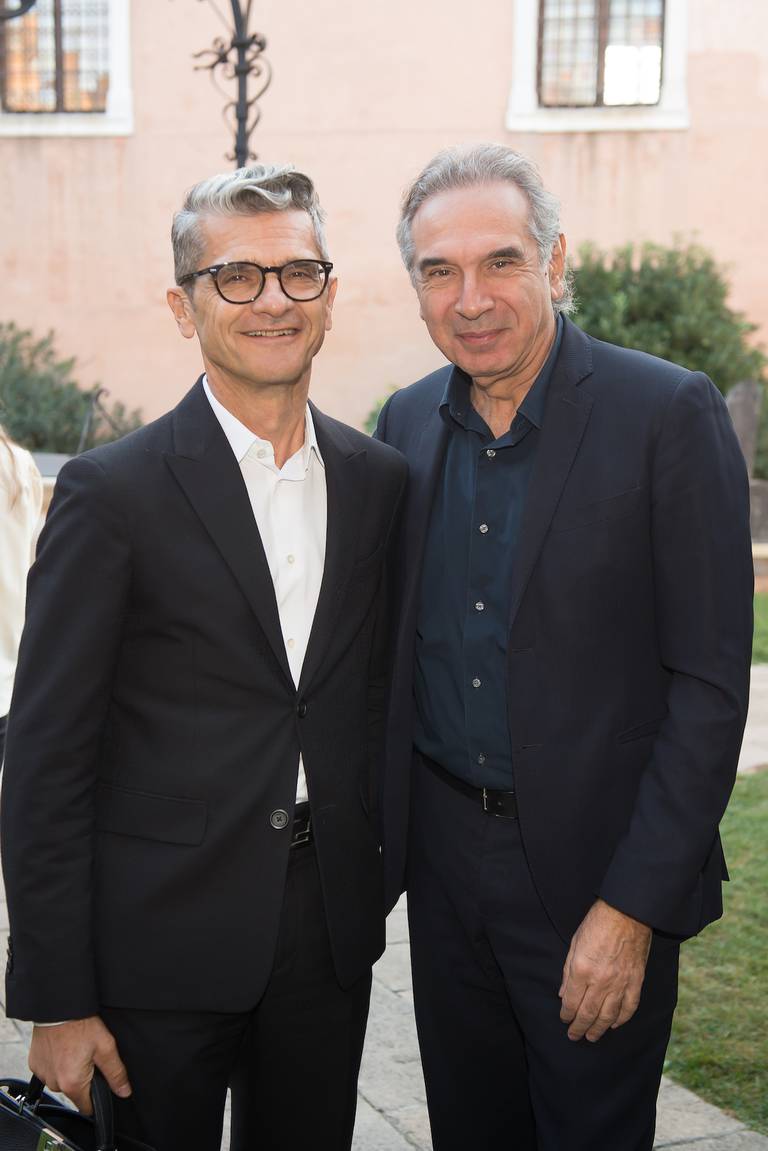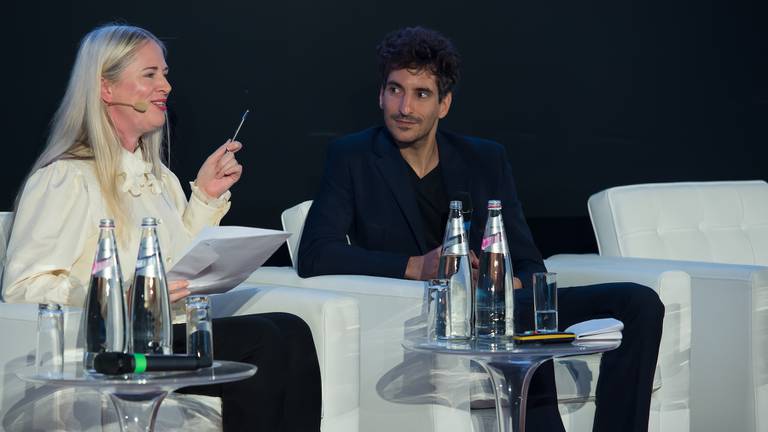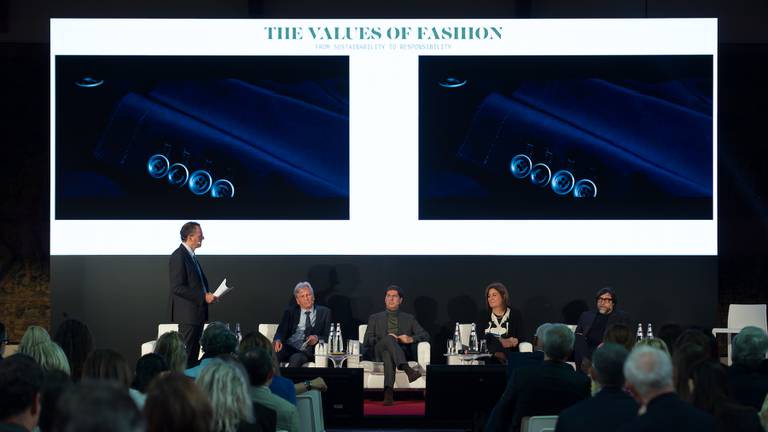
Last week, at the picturesque Fondazione Giorgio Cini — a dusky pink monastery marooned in the mouth of Venice’s Grand Canal — Camera Nazionale Della Moda Italiana (CNMI) and the Sistema Moda Italia hosted a series of talks to educate and inspire leaders from the Italian, European and international fashion industries on the urgent need to accelerate their sustainability efforts.
Partnering with the Confindustria Venezia and The European House – Ambrosetti, and with the event held in collaboration with the Ministry for Foreign Affairs and the Italian Trade Agency, it drew executives including Fendi chairman and CEO Serge Brunschwig; Prada’s head of CSR Lorenzo Bertelli; Kering’s chief sustainability officer Marie-Claire Daveu; Canali CEO Stefano Canali; Kiton CEO Antonio De Matteis; and Herno CEO Claudio Marenzi.
Joining them were founders Renzo Rosso of OTB and YNAP’s Federico Marchetti, internationally renowned experts and academics such as Kathleen Kennedy, senior director MIT Horizon and executive director MIT Center for Collective Intelligence; Simone Cipriani, chair of secretariat of the UN Alliance for Sustainable Fashion; Michael Ferraro, executive director design and technology lab (DTech) at Fashion Institute of Technology; and Fiorenzo Omenetto, director of Silklab and dean of research at Tufts University.
Many of the speakers were recipients of the CNMI Sustainable Fashion Awards, which brought the international industry to Milan last month and saw key sustainable initiatives and projects receive awards on the stage of Teatro alla Scala. One of the fundamental tenants of the CNMI’s strategy is identifying sustainable excellence and sharing best practices with the wider fashion community.
“There is a revolution to put sustainability at the core of fashion businesses, but you cannot be sustainable by yourself. Sustainability works together. This is why the entire system, big brands and small producers, are all here to find solutions. Fashion can prove that together we can do something,” said Carlo Capasa, chairman of the CNMI, in his opening remarks at the event.
Over two days of programming, industry leaders and external innovators hosted sessions dedicated to many of the most established areas of sustainable innovation and action, from circularity and eco-design principles to blockchain technology and the need for incentives and consistent metrics to measure performance to accelerate systemic change.
“Camera della Moda has tried to become a point of reference to guide these efforts,” Capasa told BoF. “What distinguishes our approach is pragmatism. We started working tables [on sustainability] 10 years ago and started to set objectives and targets. We can find solutions through innovation, research and measurability. Since then, almost all of the members of the CNMI have invested in sustainability.”
Regulation and Responsibility
The first day of the talks, entitled “Just Fashion Transition”, focused on the practical ways in which local and international supply chains and brands can collaborate to engender urgent systemic change in a fair and just way. Indeed, the requirement for the industry to unite behind shared practices is increasing, due to the the ambitious legislation planned by the EU and the need for the industry to effectively lobby and inform that process with on-the-ground insights and experiences.
Currently, the EU Commission is in the process of converting its sustainable textile strategy, released in May 2022, into legislation. Critically, EU standards and regulations will be applicable to all goods produced and imported into the EU.
By 2030, high levels of regulation are planned to be in force, including: rules on acceptable fibres; mandatory annual reporting on overproduction; requirements for every garment to have a unique digital tag identifying manufacturing processes and provenance of materials; and, critically, the expansion of extended producer responsibility (already partially present in France and Italy), which will add a levy to sales to fund the collection and processing of textile waste.
There is a revolution to put sustainability at the core of fashion businesses, but you cannot be sustainable by yourself. Sustainability works together.
Recently, CNMI coordinated and announced the The Re.Crea Consortium to manage end-of-life textile and fashion products, and to promote research and development of innovative recycling solutions. Consisting of six founding brands, Prada Group, Dolce & Gabbana, MaxMara Fashion Group, Moncler Group, OTB Group and Ermenegildo Zegna Group, and seeking more members, the consortium is a response to the European directive on “Extended Producer Responsibility for Textile Waste (EPR)”.
“When talking about sustainability, textiles is a target. But this commission has also recognised that textiles play a necessary part in creating industrial resilience in Europe,” explained Dirk Vantyghem, the director general of Euratex, the trade body representing the 140,000 textile manufacturers in the euro-zone at the European Commission.
“But how do we reconcile sustainability and competitiveness? How can sustainability become a source of competitiveness?” asked Vantyghem. “Well, there will be a strong emphasis on market surveillance. The 25 billion garments imported into [the Euro zone] will need to comply with the same standards as European goods.”

“The ambition of the commission is to get rid of all the labels and replace it with a single label. They dream of the electronic goods system of A, B, C, D, E. The problem is: what are the benchmarks that we are measuring products against? Is a cotton t-shirt better than a polyester one? That is what is being debated now,” he continued.
Another critical element to the EU’s legislation is stimulating demand for sustainable products. However, Maxine Bédat of The New Standards Institute cautioned the need to be realistic about what we can expect from consumers. “We are marketing to consumers to purchase, and at the same time asking them to buy less, or better.”
Academics on stage also emphasised the importance of technology in research and problem-solving. “We need to work in the direction of innovation and technology engaging academic research labs to solve industry problems, exploring the impact of emerging technology such as virtual reality, augmented reality, 3D Fashion Design and Biofabrication, on the entire fashion value chain,” said Michael Ferraro of FIT’s DTech Labs.
“People and machines together can actually collectively solve challenges in ways that was never able to do before, therefore collective intelligence may actually lead us to the real change we aspire to achieve when talking about sustainability,” added MIT’s Kathleen Kennedy.
Tufts University’s Fiorenzo Omenetto also shared the need to “focus on a technological and innovative use of materials, aiming at recovering and reusing materials from different sectors and leveraging the so-called spiral economy — a progressive circular economy model where the by-products of an organisation or industry becomes a component for a different one”.
Harmonisation and Education
Two of the largest businesses represented on the schedule are investing in educating consumers and employees on sustainable principles and behaviours. Throughout 2021, Prada engaged in promoting an internal culture more focused on social and environmental topics. Its partnership with UNESCO’s Intergovernmental Oceanographic Commission includes the “Sea Beyond” education project, launched in 2019 and dedicated to the promotion of ocean literacy and ocean preservation.
“At its core, our group is still a family business, and education has always been at the heart of my family. If we are more educated, it is better for the environment and better for us. If we want to create a sustainable value chain, we have to change the minds and hearts of the people who work in it. Internally, we are educating 13,000 employees in a programme called Drive the Change, through an app we created in partnership with UNESCO, and I have been impressed by the excitement of our employees. We are the driver of the change,” shared Bertelli.
Renzo Rosso’s OTB Group, which includes Diesel, Jil Sander and Maison Margiela, was an early mover in innovating its practices to become more sustainable and efficient.
“First of all, my priority was to educate our managers. I sent over 100 leaders from a mix of departments, the creative and the commercial, from the first and second lines of management, to Bocconi University for a week-long course. We wanted to promote a state of mind, so they think sustainably. After that, we invested in more sustainable materials [and] in our water processes. Now, [we use] almost 90 percent less water due to laser technology.
We can sell products just using digital representations. So, if we sell it, we make it — otherwise, we don’t make it.
“For some products, we don’t create [physical] prototypes. We can sell products just using digital representations. So, if we sell it, we make it — otherwise, we don’t make it. Less travel, less shipping, less CO2. By the end of next year, we plan to generate 50 percent of the energy we use ourselves. But it is challenging to buy solar panels because of global demand. We only use recycled plastic, if at all. There is no plastic in our offices.
“The brands in the group are all luxury and Diesel, I am moving up [its positioning]. In quality. In terms of sustainability. I want it to become more of an alternative to luxury. In the global fashion industry, 33 percent of production stays in packs, it doesn’t even reach the store. So, we can really reduce a lot. My vision for the future is that the consumer must be consuming less, but a much better product,” Rosso told BoF.
Measurement and Making
However, the need to harmonise and connect independent industry efforts as quickly as possible was a consistent theme throughout the event, especially in the current context of low levels of regulation in the market.
“Sustainable reporting at this point is an act of creative writing. The reports are not comparable, unlike, say, financial reporting, which are based on the accounting principles. So, we at The UN Alliance for Sustainable Fashion created tools in partnership with the members of the Camera della Moda for due diligence, performance monitoring, as well as reporting and communication frameworks, enable us to use the same metrics. With one set of systems, one voice, we can change things,” says Cipriani.

“If we want to be aligned with the financial performances, it’s very important to be able to measure what we are doing. You can’t manage what you can’t measure,” said Kering’s chief sustainability officer Marie-Claire Daveu. Indeed, unifying reporting standards, data sets and metrics will be critical to achieve the goal of limiting global warming to 1.5 degrees. Moving further than emissions, biodiversity is expected to be a core focus of this year’s upcoming COP27 in Egypt.
The New Standards Institute’s Bédat advised that the industry should be led by independent data to identify hot spots to ensure the industry focuses on areas where it can create the most positive impact.
“We can’t walk into these things hoping for the best and ignoring the data. We’re in the decade of really entering the weeds and figuring out how are we actually going to do this. We need to ensure that underneath all of these strategies is independent data and targets backed by science… What we need to do is figure out the business models that do actually align with planetary boundaries. I am agnostic with regards to degrowth as a concept, but what is clear is that it is almost impossible for businesses at the higher end of disposability to exist in a sustainable way,” Bédat shared.
We need to ensure that underneath all of these strategies is independent data and targets backed by science… [to] figure out the business models that do align with planetary boundaries.
Critically, positive innovation needs to be recognised commercially. “We have to align with the right incentives. What is happening in a textile mill is where 76 percent of the climate action is [for most apparel manufacturers). But when we speak to many, many mills, we hear they are making investments into energy efficiency, better certification, higher standards, but brands are not rewarding them by buying better,” says Bédat.
However, tackling fashion’s overproduction problem at its core remains the most significant lever available to the industry. “We are speaking about sustainable sourcing, sustainable processes, [but] the most important thing we have to keep in mind is to produce the right quantity. You have to use what you need in energy. And again, measure your greenhouse gas emission, and do more than offset them. But the first thing, and I think all our industry is concerned, even if, of course, we produce [in comparative] small quantities […] and that’s really to produce the right quantity of products,” says Daveu.
What’s more, companies’ abilities to navigate disruption and create business models that could one day viably sit within planetary boundaries is beginning to impact valuations and investor interest.
“What is interesting, that I think is worth mentioning, is that before I joined Kering, exactly 10 years ago, and at the beginning of this role, financial investors and financial analysts had only a very limited number of questions [that related to ESG reporting]. Now, each year, we add more [questions and responses] — it’s grown exponentially,” says Daveu.
“There is economic value in sustainability because more sustainable companies are perceived to be better positioned to weather the coming storm. Stakeholder relational capitalism is a source of revenue […] and revenue growth. If a consumer backlash against companies with [poor sustainable records] is perceived to be coming by the market, investors may run before the revenue drops. Italy is the only place in the world where you have the whole value chain present. If we can make the fashion system of Italy more sustainable, you can create a global benchmark,” said IPCC’s Cipriani.
“Getting together does not mean meeting to control one another — it means we set an objective and go after it. Together. It starts now,” he concluded.
This is a sponsored feature paid for by CNMI as part of a BoF partnership.



